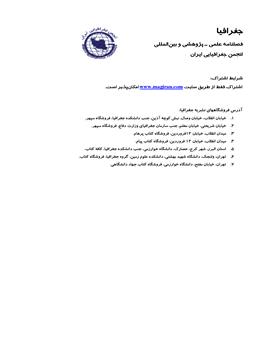Sustainable development of small bio-complexes in aspect of passive defense (A case study on Buin Zahra City)
Subject Areas :
1 -
2 -
Keywords: passive defense, sustainable development, small scale bio-complexes,
Abstract :
Cities are one of the most important and densely populated human habitats and require the physical safety and security of the infrastructure as well as sustainability and resistance in counter with natural disasters and enemies threats. Passive defense subject is one of the issues that has been considered by planners and Iranian cities planners in recent years. Urban planning has a variety of dimensions, which, considered with regard to their protection and sustainability therefore will be a great benefit in critical situations, The present research conducts to use the inactive principles of urban planning, with emphasis on residential and critical uses in small-scale cities and protecting urban spaces by providing them by defensive role also, how to protect and defend people and their places of life by enforcing the rules and considerations of passive defense in present and future. In addition, it provides grounds for the better security and stability of the city with the least possible damage during the time of the foreign invasion and even terrorist operations. In the present research, analysis have been done using GIS tools on distribution strategic locations of Buin Zahra city as a small town scale where is located in the vicinity of the Iran capital and as result and central areas of the city and Southwest margins were detected as unsafe and critical areas threats.
1. آهنی، محمدرضا؛ محسنی، بهرام (1390)، جغرافیای نظامی (طبیعی)، تهران: جلد اول دانشگاه امام حسین(ع)؛
2. برآبادی، محمود (1384)، الفبای شهر، تهران، انتشارات سازمان شهرداری¬ها و دهیاری¬های کشور؛
3. تقوایی، مسعود؛ خمسلویی، علی (1931)، مدیریت و برنامه¬ریزی بحران در فضاهای شهری با رویکرد پدافند غیرعامل و مدل SWOT مطالعة موردی مسیرهای راهپیمایی شهر اصفهان مجلة آمایش جغرافیایی، سال دوم، شمارة ششم؛
4. جدی، احمد؛ اصغریان (1391)، الزامات معمارانه در دفاع غیرعامل پایدار، تهران: انتشارات دانشگاه شهید بهشتی؛
5. خیرآبادی و همکاران (۱۳۸۸)، بررسی مکانیابی ملاحظات پدافند غیرعامل در محیط GIS، همایش سراسری سامانه اطلاعات مکانی، تهران؛
6. دهخدا، علی¬اکبر(1351)، لغت¬نامۀ دهخدا؛ جلدچهارم، انتشارات دانشگاه تهران، تهران؛
7. رهنمایی، محمدتقی و سیدموسی پورموسوي(1385)، بررسی ناپایداري¬هاي امنیتی کلان¬شهرتهران، براساس شاخص¬هاي توسعه پایدار شهري، فصلنامۀ پژوهش¬هاي جغرافیایی، شمارة 57؛
8. زیاري، کرامت ا... (1385)، برنامه¬ریزي پدافند و پناهگاه شهري، نشریه صفه، دانشگا شهید بهشتی، سال ۱۱، شماره ۳۲؛
9. عبدالهی، مجید (1382)، مدیریت بحران در نواحی شهري، انتشارات سازمان شهرداريهاي کشور، تهران؛
10. نباتی، عزت ا... (1388)، مبانی پدافند غیرعامل، دانشکده علوم و فنون فارابی، تهران؛
11. نيازتبار، حسن (1386)، آسيب¬شناسي پدافند غيرعامل در برابر اقدامات (NBC)، نشريه مديريت نظامي، شـماره . 2۵؛
12. فرجی، امین؛ حسینی¬امینی، حسن (1394)، آمایش دفاعی سرزمین از منظر پدافند غیرعامل، نشریه جغرافیا، شماره(45)؛
13. مدیری، مهدی؛ کرمی، مهرداد؛ انصاری¬زاده، سلمان؛ حیدری¬موصلو، طهمورث (1392)؛ شاخص¬های امنیت¬ساز پدافند غیرعامل در آمایش سرزمین، فصلنامه راهبرد دفاعی، شمارۀ41؛
14. Lucas L. F. Janssen, (2012), Principles of Remote Sensing, volume 2 of ITC Educational Textbook Series. International Institute for Aerospace Survey and Earth Sciences, Enschede, The Netherlands;
15. Register,R., (2013), Ecocity Berkeley: building cities for a healthy future, London;
16. S. Caula.,G.T.Hvenegaard.,P.Marty, (2012), The influence of bird information, attitudes, and demographics on public preferences toward urban green spaces: The case of Montpellier, Urban Forestry & Urban Greening, France;
17. Thomas, H., (2012), Urban Renaissance and Social Justice, New York.


